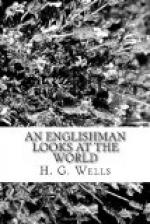And at the other end of the scale, also, one misses an element. There is no territorial aristocracy, no aristocracy at all, no throne, no legitimate and acknowledged representative of that upper social structure of leisure, power and State responsibility which in the old European theory of Society was supposed to give significance to the whole. The American community, one cannot too clearly insist, does not correspond to an entire European community at all, but only to the middle masses of it, to the trading and manufacturing class between the dimensions of the magnate and the clerk and skilled artisan. It is the central part of the European organism without either the dreaming head or the subjugated feet. Even the highly feudal slave-holding “county family” traditions of Virginia and the South pass now out of memory. So that in a very real sense the past of the American nation is in Europe, and the settled order of the past is left behind there. This community was, as it were, taken off its roots, clipped of its branches, and brought hither. It began neither serf nor lord, but burgher and farmer; it followed the normal development of the middle class under Progress everywhere and became capitalistic. The huge later immigration has converged upon the great industrial centres and added merely a vast non-servile element of employees to the scheme.
America has been and still very largely is a one-class country. It is a great sea of human beings detached from their traditions of origin. The social difference from Europe appears everywhere, and nowhere more strikingly than in the railway carriages. In England the compartments in these are either “first class,” originally designed for the aristocracy, or “second class,” for the middle class, or “third class,” for the populace. In America there is only one class, one universal simple democratic car. In the Southern States, however, a proportion of these simple democratic cars are inscribed with the word “White,” whereby nine million people are excluded. But to this original even-handed treatment there was speedily added a more sumptuous type of car, the parlour car, accessible to extra dollars; and then came special types of train, all made up of parlour cars and observation cars and the like. In England nearly every train remains still first, second and third, or first and third. And now, quite outdistancing the differentiation of England, America produces private cars and private trains, such as Europe reserves only for crowned heads.
The evidence of the American railways, then, suggests very strongly what a hundred other signs confirm, that the huge classless sea of American population is not destined to remain classless, is already developing separations and distinctions and structures of its own. And monstrous architectural portents in Boston and Salt Lake City encourage one to suppose that even that churchless aspect, which so stirred the speculative element in Mr. Henry James, is only the opening formless phase of a community destined to produce not only classes but intellectual and moral forms of the most remarkable kind.




